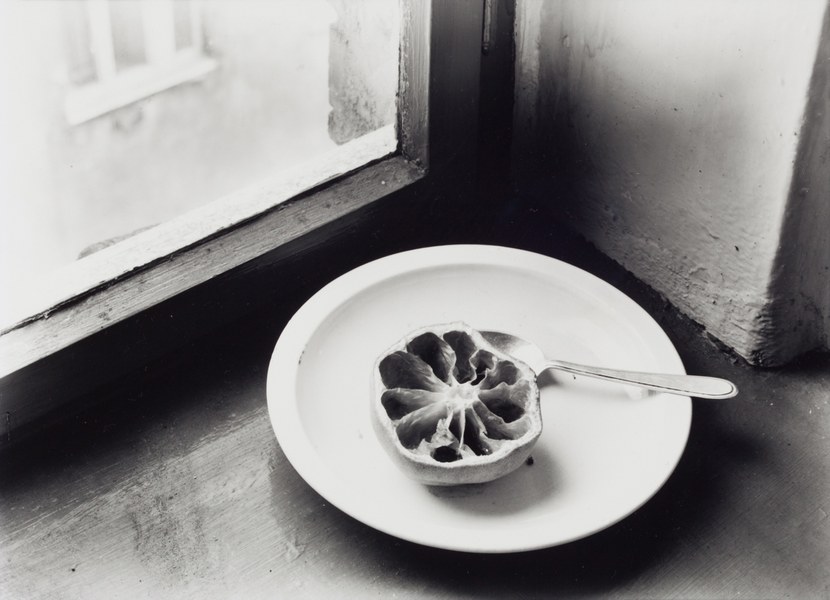
Manfred Paul, Pampelmuse mit Löffel, 1984, ©Manfred Paul
Manfred Paul – Nature Morte 1983 – 1985
Opening: Januar 12, 2018 | 7–9pm
January 13 – April 14, 2018
Loock Galerie is pleased to present, in its showroom, a presentation of the series Nature Morte 1983 – 1985 of German photographer Manfred Paul. Inspired by the motive of Vanitas, his photographs are a reflection on life as well as a depiction of the notion of intimacy in the GDR.
Manfred Paul is an important representative of East German photography. Alongside Arno Fischer or Sibylle Bergemann, he contributed to shape a multifaceted image of a period that was often oversimplified. Born in 1942 in Schraplau, he has been living in Berlin since the 1960´s. He worked as a theatre photographer as well as a freelance photojournalist. He studied simultaneously photography at the Hochschule für Bildende Künste (HGB) Leipzig and camera at the Hochschule für Film und Fernsehen in Potsdam-Babelsberg. Since 1974, he has been working as lecturer and professor at various educational institutions such as the Hochschule für Fernsehen und Film (HFF) in Munich, the Fachhochschule für Technik und Wirtschaft (FHTW) in Berlin or the HGB Leipzig. In 2013, he participated in the exhibition “The Shuttered Society – Art Photography in the GDR 1949–1989” at the Berlinische Galerie. In 1967, when he moved from Schraplau to Prenzlauer Berg in Berlin, he started exploring the neighborhood with his camera. He rapidly felt the unconscious need to document a world that he sensed was only temporary. Walls, cul-de-sacs and inner courtyards are recurrent subjects in his photographs, like visual metaphors of a restrictive regime that Manfred Paul could not directly criticize. He also found a certain beauty in these old buildings marked by the effects of war. In fact, he saw in them a material reminder of the passage of time and the fate to which our lives are destined. As he set his camera in the courtyards, the residents invited him into their apartments and their intimacy. Behind the desolate walls, life went on. He photographed ashtrays, vases, or dirty dishes as an ode to life, revealing that everyone’s existence is only a sequence of trivial, raw and mundane scenes, yet powerfully beautiful. As he said:
“Vielleicht geht es darum, den Dingen mit bestimmter Demut zu begegnen. Und wenn man sie überhaupt wahrnehmen darf, ist das schon ein Glück, eigentlich.”*
[Perhaps the issue is to confront things with a certain humility. And if we are allowed to perceive them at all, we are actually lucky.]
His still life images depicting eggs, rotting fruit, or fish also echo the Vanitas or Memento mori. It is nothing less than a reminder of the transcience of life and the necessity to grasp every second of it. Manfred Paul belongs to a long line of artists who have all been trying to make sense of the inevitability of death and the meaning of life. This ceaseless quest is encapsulated in his photographs:
“Vielleicht sind Bilder eine Möglichkeit, überhaupt Leben zu begreifen. Zumindest Metaphern zu finden, wie man sich Leben erklärt und man stellt aber immer fest, dass es eigentlich nicht fassbar ist. Aber es ist ja so mit dem Werden und Vergehen, also überhaupt mit dem Vergehen, dass alles am Tod beendet wird.“*
[Perhaps pictures are a way of grasping life. Or at least of finding metaphors to explain life, and then you keep realizing that it can’t really be captured. But it is true with becoming and decaying, well, especially with decaying, that everything ends with death.]
Manfred Paul´s photographs have been shown in numerous solo and group shows, including dkw Kunstmuseum Dieselkraftwerk Cottbus (2016); Forum für Fotografie, Cologne (2015); NRW Forum Düsseldorf DZ Bank (2014); Berlinische Galerie Landesmuseum für Moderne Kunst (2013 und 2012); Kunsthalle Kopenhagen (1996); Musée de l´Elysee, Lausanne (1990). Works by Manfred Paul are a. o. in the following private and public collections: Berlinische Galerie, Bibliothèque Nationale de France, dkw Kunstmuseum Dieselkraftwerk Cottbus, DZ Bank Frankfurt/Main, Kupferstich-Kabinett Dresden, Musée de l’ Elysée Lausanne, Museum Ludwig Köln, Museum of Modern Art, New York, Staatliche Museen zu Berlin.
*(Source: Manfred Paul in an interview with Deutschlandfunk Kultur, 2016)